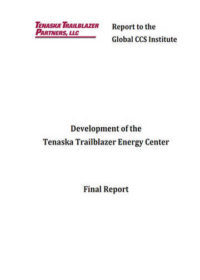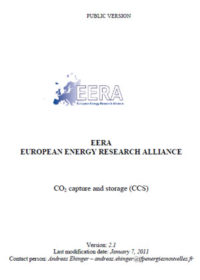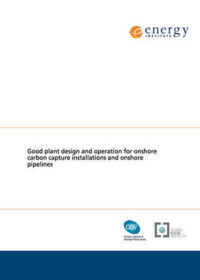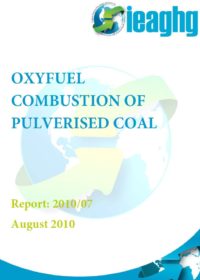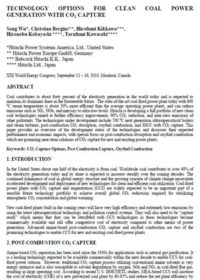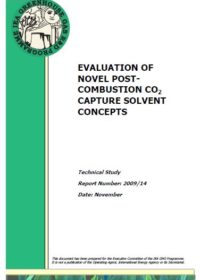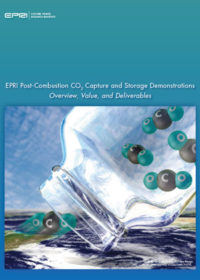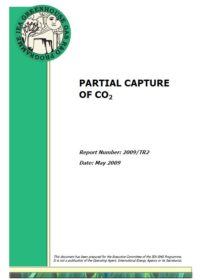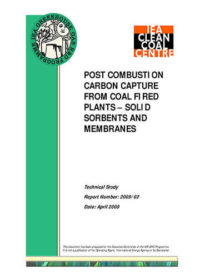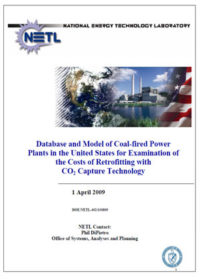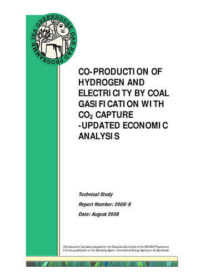Resources
Publications
Our publications, reports and research library hosts over 500 specialist reports and research papers on all topics associated with CCS.
View our Publication Library Disclaimer.
Filter by
Development of the Tenaska Trailblazer Energy Center
31st January 2011
Topic(s): Carbon capture use and storage (CCUS), CO2 capture
This paper discusses the development of the Tenaska Trailblazer Energy Center, a supercritical pulverized coal electric generating station under development in Nolan County, Texas, United States. The site is located approximately nine miles east of Sweetwater, Texas and it is expected to be the first new-build coal plant to incorporate a commercial-scale carbon dioxide capture plant into the initial design. This report describes the history of the project development and looks at some of the key challenges being faced by the Project, including permitting, water supply and financing.
Disclaimer
The content within the Global CCS Institute Publications, Reports and Research Library is provided for information purposes only. We make every effort and take reasonable care to keep the content of this section up-to-date and error-free. However, we make no claim as to its accuracy, currency or reliability.
Content and material featured within this section of our website includes reports and research published by third parties. The content and material may include opinions and recommendations of third parties that do not reflect those held by the Global CCS Institute.
CO2 capture and storage (CCS): version 2.1
7th January 2011
Topic(s): Carbon capture use and storage (CCUS), CO2 capture, CO2 storage
This publication describes the European Energy Research Alliance’s (EERA) the Carbon Capture and Storage Joint Programme (CCS-JP) and how it adds value through the enhanced coordination and cooperation of the activities of the major European R&D players in CCS.
Disclaimer
The content within the Global CCS Institute Publications, Reports and Research Library is provided for information purposes only. We make every effort and take reasonable care to keep the content of this section up-to-date and error-free. However, we make no claim as to its accuracy, currency or reliability.
Content and material featured within this section of our website includes reports and research published by third parties. The content and material may include opinions and recommendations of third parties that do not reflect those held by the Global CCS Institute.
Coal-fired power plants in the United States: examination of the costs of retrofitting with CO2 capture technology, revision 3
4th January 2011
Topic(s): Carbon capture use and storage (CCUS), CO2 capture
Retrofitting existing coal-fired power plants to capture CO2 is an important GHG mitigation option for the United States. Coal power plants are large point sources and account for roughly 37% of total U.S. CO2 emissions. Also, retrofitting utilizes the base power plant and related infrastructure and so the cost and level of disruption could be less than other greenhouse gas mitigation options. NETL studied the 738 coal-fired generating units currently operating in the United States and estimated how much the capital cost and parasitic load for CO2 retrofit would vary from unit to unit. Site-specific characteristics such as base plant efficiency, whether or not the unit has a sulfur scrubber, the efficiency of the sulfur scrubber, how much water is available for the unit to use, and how much space is available for the CO2 capture and compression equipment were factored in to an estimate of CO2 capture cost at each generating unit.
Disclaimer
The content within the Global CCS Institute Publications, Reports and Research Library is provided for information purposes only. We make every effort and take reasonable care to keep the content of this section up-to-date and error-free. However, we make no claim as to its accuracy, currency or reliability.
Content and material featured within this section of our website includes reports and research published by third parties. The content and material may include opinions and recommendations of third parties that do not reflect those held by the Global CCS Institute.
Good plant design and operation for onshore carbon capture installations and onshore pipelines: a recommended practice guidance document
1st September 2010
Topic(s): Carbon capture use and storage (CCUS), CO2 capture, CO2 transport
Published jointly by the Energy Institute and the Global Carbon Capture and Storage Institute. This new title is an essential guide for engineers, managers, procurement specialists and designers working on global carbon capture and storage projects.
This document provides:
- an overview of CCS technology including what plant equipment is novel and what is currently in use within the CCS or other industries;
- an in depth guide to carbon dioxide to broaden the readers understanding of the material and its health and safety issues;
- key design features of plant and pipelines for carbon dioxide service including experience gained from the industrial gases sector; and
- key operational information for plant and pipelines for carbon dioxide service including experience gained from the industrial gases sector to ensure that your operating practices take into account the latest operational experiences from carbon dioxide plant.
Disclaimer
The content within the Global CCS Institute Publications, Reports and Research Library is provided for information purposes only. We make every effort and take reasonable care to keep the content of this section up-to-date and error-free. However, we make no claim as to its accuracy, currency or reliability.
Content and material featured within this section of our website includes reports and research published by third parties. The content and material may include opinions and recommendations of third parties that do not reflect those held by the Global CCS Institute.
Oxyfuel combustion of pulverised coal
24th August 2010
Topic(s): Carbon capture use and storage (CCUS), CO2 capture
This report concentrates on the oxyfuel combustion of pulverised coal with recycled flue gas. Oxyfuel combustion is one of the leading options for power generation with CO2 capture. It can be simply described as a process that eliminates nitrogen from the oxidant or comburent by burning the fuel in either nearly pure oxygen or a mixture of nearly pure oxygen and a CO2-rich recycled flue gas (RFG) resulting in a product flue gas from the boiler containing mainly carbon dioxide and water vapour. Pulverised coal is burned with a mixture of CO2-rich recycled flue gas or steam (to act as diluents replacing nitrogen in order to moderate the temperature) in addition to the oxygen from an air separation unit. In the current design of the oxyfuel combustion for pulverised coal fired boilers, the CO2-rich recycled flue gas is used as the diluent. The contents of this report include: a discussion of ignition and flame propagation, combustion and burnout, and heat transfer.
Disclaimer
The content within the Global CCS Institute Publications, Reports and Research Library is provided for information purposes only. We make every effort and take reasonable care to keep the content of this section up-to-date and error-free. However, we make no claim as to its accuracy, currency or reliability.
Content and material featured within this section of our website includes reports and research published by third parties. The content and material may include opinions and recommendations of third parties that do not reflect those held by the Global CCS Institute.
Technology options for clean coal power generation with CO2 capture
1st July 2010
Topic(s): Carbon capture use and storage (CCUS), CO2 capture
This paper provides an overview of the development status of CO2 capture technologies and discusses their expected performance and economic impacts, with special focus on post-combustion absorption and oxyfuel combustion which are promising near-term solutions of CO2 capture for new and existing power plants.
Disclaimer
The content within the Global CCS Institute Publications, Reports and Research Library is provided for information purposes only. We make every effort and take reasonable care to keep the content of this section up-to-date and error-free. However, we make no claim as to its accuracy, currency or reliability.
Content and material featured within this section of our website includes reports and research published by third parties. The content and material may include opinions and recommendations of third parties that do not reflect those held by the Global CCS Institute.
Evaluation of novel post-combustion CO2 capture solvent concepts
9th November 2009
Topic(s): Carbon capture use and storage (CCUS), CO2 capture
This review looked at solvents other than MEA that could be used for post-combustion CO2 capture in the near term. The purpose of this review was to outline the current state of knowledge and provide an assessment of the following aspects:
- Process chemistry and kinetics,
- Operational issues and major development issues,
- Qualitative evaluation of the performance of absorber and stripper column,
- Safety and Environmental Impact considerations.
- Technology maturity and reported time scale for commercialisation.
Disclaimer
The content within the Global CCS Institute Publications, Reports and Research Library is provided for information purposes only. We make every effort and take reasonable care to keep the content of this section up-to-date and error-free. However, we make no claim as to its accuracy, currency or reliability.
Content and material featured within this section of our website includes reports and research published by third parties. The content and material may include opinions and recommendations of third parties that do not reflect those held by the Global CCS Institute.
EPRI post-combustion CO2 capture and storage demonstrations: overview, value, and deliverables
1st October 2009
Topic(s): Carbon capture use and storage (CCUS), CO2 capture, CO2 storage
The Electric Power Research Institute, Inc. (EPRI) has examined options for reducing greenhouse gas (GHG) emissions from the electric sector. This publication details EPRI’s analysis, showing significant potential carbon dioxide (CO2) reduction from advanced coal power systems that include CO2 capture and storage (CCS) technology, making such systems likely to be an essential component of a full portfolio of GHG reductions strategies.
Disclaimer
The content within the Global CCS Institute Publications, Reports and Research Library is provided for information purposes only. We make every effort and take reasonable care to keep the content of this section up-to-date and error-free. However, we make no claim as to its accuracy, currency or reliability.
Content and material featured within this section of our website includes reports and research published by third parties. The content and material may include opinions and recommendations of third parties that do not reflect those held by the Global CCS Institute.
This report is a brief review of the technology and costs of partial capture of CO2. The report does not attempt to prescribe policies for mandating CO2 capture and whether partial capture should be part of a policy for reduction of greenhouse gas emissions. IEA GHG provides technical information which can be used by policy makers but it does not intend to be policy prescriptive.
Disclaimer
The content within the Global CCS Institute Publications, Reports and Research Library is provided for information purposes only. We make every effort and take reasonable care to keep the content of this section up-to-date and error-free. However, we make no claim as to its accuracy, currency or reliability.
Content and material featured within this section of our website includes reports and research published by third parties. The content and material may include opinions and recommendations of third parties that do not reflect those held by the Global CCS Institute.
Post combustion carbon capture from coal fired plants: solid sorbents and membranes
1st April 2009
Topic(s): Carbon capture use and storage (CCUS), CO2 capture
This report will begin with mesoporous and microporous adsorbents in which CO2 adsorption is simply a physical process controlled by the pore characteristics of the sorbent. The addition of chemical functionality such as amine groups has been studied as a means of improving the performance of porous adsorbents so this will be discussed in the following chapter. The next chapter will examine regenerable solid sorbents, mostly involving a chemical cycle of calcination/carbonation reactions to capture the CO2 and then release it as a pure gas while regenerating the sorbent. A chapter on membranes will follow. The final chapters will provide a brief discussion on techno-economic studies followed by some comments and conclusions.
Disclaimer
The content within the Global CCS Institute Publications, Reports and Research Library is provided for information purposes only. We make every effort and take reasonable care to keep the content of this section up-to-date and error-free. However, we make no claim as to its accuracy, currency or reliability.
Content and material featured within this section of our website includes reports and research published by third parties. The content and material may include opinions and recommendations of third parties that do not reflect those held by the Global CCS Institute.
Database and model of coal-fired power plants in the United States for examination of the costs of retrofitting with CO2 capture technology
1st April 2009
Topic(s): Carbon capture use and storage (CCUS), CO2 capture, Economics
Disclaimer
The content within the Global CCS Institute Publications, Reports and Research Library is provided for information purposes only. We make every effort and take reasonable care to keep the content of this section up-to-date and error-free. However, we make no claim as to its accuracy, currency or reliability.
Content and material featured within this section of our website includes reports and research published by third parties. The content and material may include opinions and recommendations of third parties that do not reflect those held by the Global CCS Institute.
Co-production of hydrogen and electricity by coal gasification with CO2 capture: updated economic analysis
27th August 2008
Topic(s): Carbon capture use and storage (CCUS), CO2 capture, Energy efficiency
IEA GHG has published a report on co-production of hydrogen and electricity with CO2 capture in September 2007. In the time since the cost estimates in that report were prepared there have been large increases in coal prices and plant construction costs. Foster Wheeler Italiana, who undertook the original co-production study, has produced updated cost estimates taking account of these changes. This work was requested and funded by the Netherlands General Energy Council and managed by IEA GHG.
Disclaimer
The content within the Global CCS Institute Publications, Reports and Research Library is provided for information purposes only. We make every effort and take reasonable care to keep the content of this section up-to-date and error-free. However, we make no claim as to its accuracy, currency or reliability.
Content and material featured within this section of our website includes reports and research published by third parties. The content and material may include opinions and recommendations of third parties that do not reflect those held by the Global CCS Institute.
